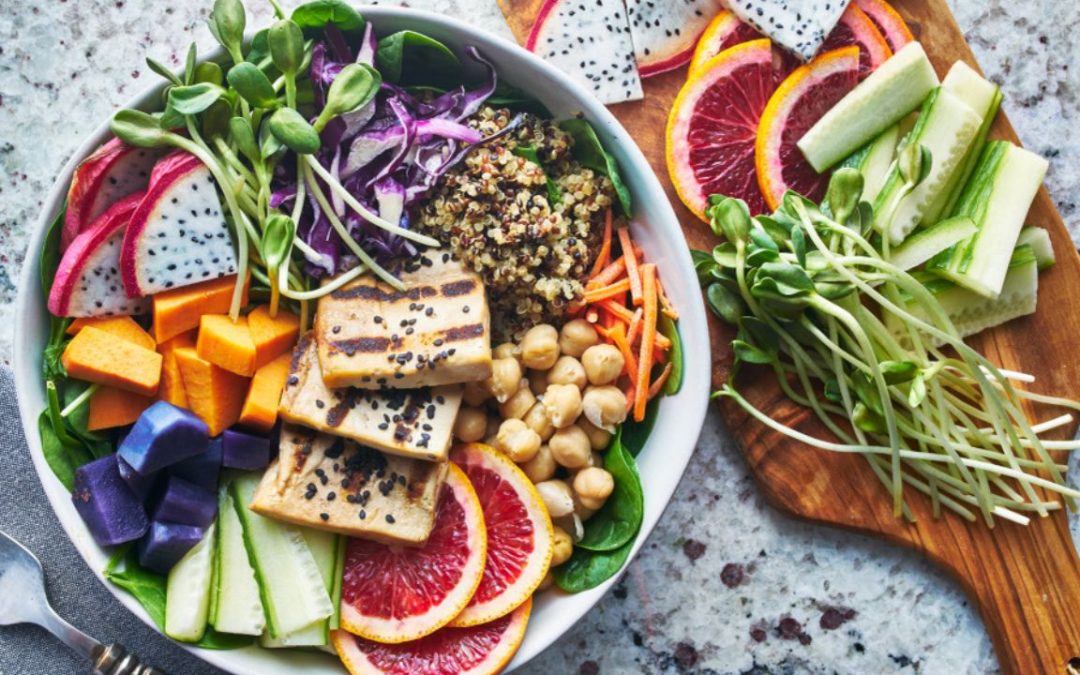We hear a lot about protein in the sustainable foods industry – some products are called alternative proteins, after all — but how important are proteins to our diet, really? Turns out, pretty important.
First, let’s define proteins and their functions, and then we’ll get more information from an expert.
What are proteins and how do our bodies use them?
As Dr. Costa explained so well earlier this month, proteins are strings of amino acids that our bodies break down and then put back together or repurpose. Health class in middle or high school may have taught us to think of proteins like Lego blocks, building and repairing our bodies’ tissues.
Proteins also play many other roles in our bodies’ functioning, though:
- Some proteins, enzymes, support chemical reactions that allow for digestion, muscle contraction, energy production and blood clotting.
- Other proteins make up hormones like insulin, human growth hormone, and tryptophan, that carry messages between cells and organs with instructions to do things like take up sugar, grow, or go to sleep.
- Some provide structure – keratin, collagen and elastin provide the right balance of rigidity and flexibility to our nails and hair, tendons and skin, and lungs and arteries.
- Others help maintain the proper pH in our blood, balance our fluid levels, help form antibodies to fight infection, and transport substances like oxygen in our bloodstreams.

We sat down recently with ESA Chief Science Officer, Dr. Mervyn de Souza to ask a few more questions, and his answers were, as always, illuminating.
How much protein do we really need? How likely is an American, for instance, to suffer from protein deficiency?
The Recommended Dietary Allowance (RDA) for protein is a modest 0.8 grams of protein per kilogram of body weight. Most people get more than enough protein.
To determine your daily protein intake, you can multiply your weight in pounds by 0.36. For a 50-year-old woman who weighs 140 pounds and who is sedentary (doesn’t exercise), that translates into 53 grams of protein a day.
An example might be: 3 oz steak (26g), one egg (6g), 6 oz of Greek yogurt (18g) and half a cup of green peas (4g) per day. That would easily take care of her protein needs for the day.
Age, gender and activity level can all move the needle in one direction or another, but that formula gives a good ballpark number to aim for.
I believe that in the end, it’s the flexitarians who will win and who will save the day and the planet!
Dr. Mervyn de Souza
Do we need protein at every meal, or do we just need a center-of-the-plate player, an entrée?
Yes, we need protein with every meal since there is limited absorption of protein at any one time. In fact, it’s important to spread out the intake to ensure sufficient and efficient uptake and utilization of protein by the body.
- BLOOD SUGAR CONTROL
Replace some of the carbohydrates on your plate with protein to reduce elevated blood-glucose levels. A moderate amount of protein digests slowly enough so that it doesn’t increase blood glucose. When you eat protein during a meal, it stops your post-meal blood sugar from spiking. The American Diabetes Association recommends eating protein at every meal in servings that make up about one quarter of your plate. Some healthy protein choices include beans, seafood, poultry, eggs and cheese. - WEIGHT LOSS SUPPORT
University of Missouri researchers compiled results from 24 studies and found that eating protein at every meal results in fat loss and muscle preservation. Protein satisfies hunger and reduces unhealthy impulse snacking. - CONCENTRATION AND FOCUS
Protein is beneficial for concentration and may even prolong the efficacy of ADHD medications. Research points to a deficiency in tryptophan, an essential amino acid found in protein, in the brains of those with ADHD. Tryptophan is a precursor to the neurotransmitter serotonin, a lack of which can contribute to difficulties in focus. For best results, eat protein in small to moderate amounts with every meal. - MUSCLE HEALTH
Protein builds and repairs muscles, but dividing your total intake into portions spread throughout the day will optimize protein absorption and muscle health. Researchers at the University of Texas Medical Branch used volunteers in a study involving a protein-consumption schedule and muscle-tissue synthesis analysis. Their results show that those who ate protein in consistent amounts over the course of the day had a 25-percent greater muscle-synthesis rate than those who saved the bulk of their protein for dinner.

Are insects and cell-based meats better protein sources for us from purely nutritional standpoints, since they’re animal proteins?
I believe that in the end, it’s the flexitarians who will win and who will save the day and the planet! Having viable, affordable nutritional options for various dietary preferences/requirements seems to be a logical outcome from the explosion of research and innovation in the plant based and alternative protein space. That might be fungi, insects, precision fermentation, plants etc.
Having nutritious and affordable options is also critical when thinking globally beyond just the western world and people with disposable income – we need to democratize good nutrition for all!
Insects have gained more traction as food in Latin America and Africa, where there are fewer cultural barriers and less hesitancy. Insects offer such great nutrition, sustainability, and ease of harvest. In America, I hear conversations at some large food manufacturers, not about developing insect products for scaled-up human consumption, yet, by any means, but conversation. I don’t see crickets on American restaurant menus any time soon, but insects as feed, for farm-raised fish and animals, are projected to be commercialized by 2024 or thereabouts.
Also on the horizon, cellular agriculture will mean meat that’s exactly the same as the original cell source, without killing the animal and the multitude of associated environmental impacts. We can expect it to have the same amounts and kinds of protein as conventional animal meat, and our bodies to treat it the same.
That being said, what matters most is that we stop thinking about “get more protein” as “eat more meat.” Beef, poultry, and pork (as well as milk, cheese, and eggs) provide high-quality protein, but so can many plant foods — including whole grains, beans and other legumes, nuts, and vegetables.

We also have to consider the protein “package” — the fats, carbohydrates, vitamins, minerals, and other nutrients that invariably come along with protein. Plants provide holistic benefits and balance in our diets – fiber, micro-nutrients, antioxidants etc. I had started using the phrase, “We need to put the plant back in plant-based foods,” and now I’m glad to hear it from multiple sources.
What about over-eating protein? We asked about too little – can a person have too much protein?
We can only absorb and access a limited amount of protein at a time so piling it on at any one meal just means that a lot of it goes to waste or gets converted into ammonia (creating alkaline conditions) in the gut which has adverse repercussions. That’s another reason to spread protein consumption out, throughout the day, rather than waiting to have protein just at dinner.
Dietary diversity also really matters when it comes to various nutritional sources of protein and of our entire diets. Without a diverse food source, it’s impossible to have a diverse microbiome population. There is a direct link from a varied diet to gut microbiome diversity, which is critical for our good health and wellbeing.
Thank you so much, Dr. de Souza!
Next time, Dr. de Souza will discuss gut pH (alkaline/acidic) and how it influences the microbiome – the probiotics, prebiotics and postbiotics that we hear about but might not fully understand.

Dr. de Souza is a passionate global business leader, with a unique combination of commercial and technical experience. He is Chief Science Officer at ESA, and you can find him on LinkedIn.


Recent Comments